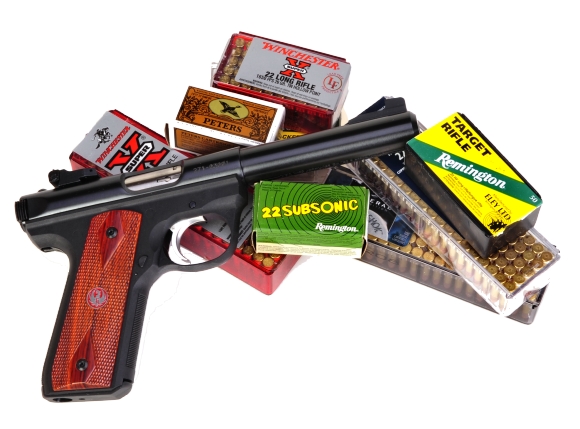
Some people would look at this picture and just see a gun with a pile of ammo. Some would look at it and see a photograph of questionable technical composition. I look at it and think, “Now there’s a fun day”. And, as it turned out, I had the inside line on this one.
No, the 22/45™ is not a clever autoloading over and under….
The Ruger 22/45™ was the product of Ruger designer, Jim McGarry. The project began in response to the growing success and functional and cost savings benefits of poly framed guns and culminated in the first production shipments in 1992*. There is a little irony at work here in that one of McGarry’s design elements was elimination of separate grip panels, while removable grip panels is a specific feature of the newest release, catalog # P512MKIIIRP. OK, maybe not a lot of irony.
In the text that follows I will refer to the Mark III and 22/45™ as those they are different models. In reality, the 22/45™ is a version of the Mark III. So where both are noted, this indicates a comparison between the traditional Mark III and the 22/45™ derivative. OK, that was a very convoluted explanation, but I will assume it was clear enough to be understood.
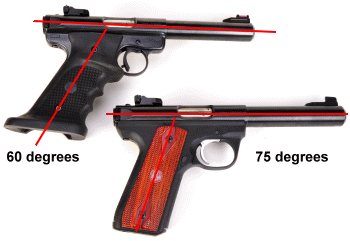 Primarily, what differentiates the 22/45™from the traditional Mark III™ product line is the Zytel Polymer frame – a fiberglass reinforced plastic, modest mechanical design changes to accommodate the use of a poly frame, and a grip angle that is consistent with a 1911 type autoloader.
Primarily, what differentiates the 22/45™from the traditional Mark III™ product line is the Zytel Polymer frame – a fiberglass reinforced plastic, modest mechanical design changes to accommodate the use of a poly frame, and a grip angle that is consistent with a 1911 type autoloader.As noted in the picture, right, the 22/45™, bore centerline to grip angle, is 15° closer to perpendicular than that of the Mark III. The 22/45™ CG is at the trigger pivot pin, 4.25″ from the bolt ears of the 9.50″ long pistol.
At physical midpoint of the loaded gun’s overall length, the weight distribution is 47%-53% fore-aft. For me, the 22/45™ has a more balanced feel than the Ruger Mark III series and it has a more natural point. Might be the result of many years of hammering away 1911 type guns that caused the 22/45™ to have a more intuitive feel but, whatever the reason, this change in geometry made a noticeable difference during live fire where hits on reactive targets were easy to come by. Again, for personal preference, this gun’s 5.50″ barrel length works for me. Shorter barrels are less steady on target and longer barrels tend to droop on target on an active day of shooting.
Replaceable panels…
Before making a comment on the 22/45™ replaceable panel feature, I want to say that the Ruger ships from the factory with really nice set of checkered cocobolo grips that are on par with the best mass produced exotic wood grips I’ve seen. At the time of this writing, Ruger was offering same type replacement grips only, but perhaps they will add a variety of accessory grips in the near future.
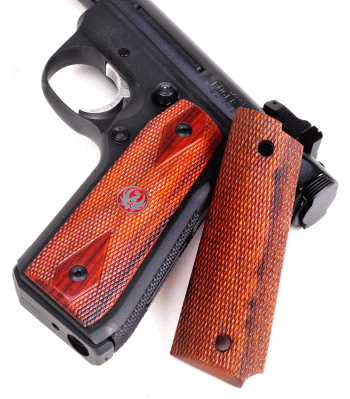
The 22/45™ shares a slab sided frame and grip fastener spacing with the 1911 auto. In fact, it was easy to mount a set of 1911 grips on the Ruger. 22/45™, however, owners are unable to tap into the existing inventory of mass produced wood grips made for the 1911, because the grip panel relief cuts that are standard for the 1911; left side relief for thumb safety/plunger tube and mainspring housing pin, right side magazine release catch and mainspring housing pin are not applicable to the Ruger.
I’m sure any shop making custom grips for the 1911 would be able to fashion a set for the Ruger at a reasonable cost and I am sure making a set from 1911 type blanks would make for an interesting weekend project. And like every other market opportunity, I am sure there will be lots of folks producing sets specifically for the 22/45™.
I see the removable panels as a solid upgrade to the earlier one piece frame with molded integral grips. Aesthetics are always an important part of firearm ownership and the removable panels provide another way for a 22/45™ owner to express their personal tastes. This is also a well executed poly frame. The matte finish and lack of mold parting lines project an image of quality.
The heart of the matter…
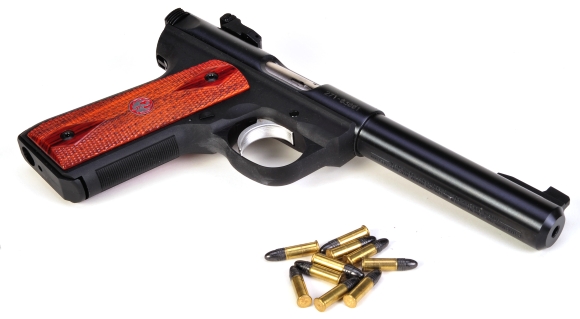
My wife and I brought a collection of .22 LR autoloading pistols out to the range, guns made by a variety of manufacturers, a variety of vintages and in various of stages of recreational target shooting tune. The 22/45™, for both of us, was the easiest gun to shoot. It took far less critical concentration to get and stay on target, to the extent it was a real confidence builder. While the grip angle did a great deal to give the Ruger a natural point, the three and one half pound trigger was outstanding. The pull was clean and consistent… the release was crisp and short after a light take up and the timing was such that I don’t believe I missed having an overtravel adjustment.
We burned up a good deal of ammo of varying types, subsonic to hyper velocity and the gun handled all of it without complaint. It seemed to like Winchester 40 grain round nose ammo the best. Shooting from a rest, fifty foot five shot groups, the best was 5/8″ and the greatest spread was 1 3/8″ which is certainly good enough for recreational target shooting… or recreational squirrels. For peace of mind, the Ruger has a number of unobtrusive safety features: thumb safety, magazine disconnect, integral lock, a loaded chamber indicator, and the slide locks open on empty… every time.
Not noted in the accessory catalog…
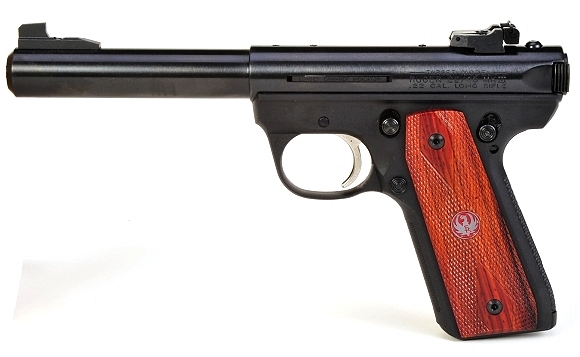
The Ruger 22/45™ has very good sights; positive in adjustment, elevation and windage, with a clean non-reflective blade front sight. Unfortunately, I am very old… something on the order of a hundred and six, so I need all the help I can get to find a target.
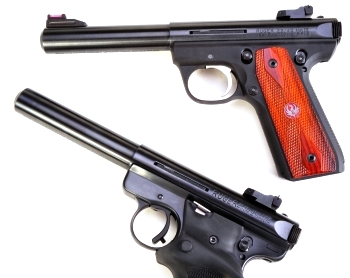
The Mark II, III and 22/45™ with non-tapered barrels share common sight placement, barrel radius and 0.375″ front sight height. Pictured left is the result of a five minute sight swap between my Mark III target gun and the 22/45™. Either a replacement Mark III fiber optic sight or the Ruger item # 84147 Mark II & III five color sight set will work on the22/45™.
For me it is a worthwhile sight change. The fiber optic gathers a lot of light and really stands out in contrast to virtually any backdrop while, at 0.075″ in diameter, the Hi Viz sight does not look like a target hiding giant blob sitting on the end of the barrel.
Just add ammo and stir…

|
The specifications noted for the 22/45™ are for the replaceable panel model. Ruger offers three other 22/45™ models as well as distributor exclusive runs. In addition to removable grip panels, models vary in barrel length and application of fluting, type of sights and in material of manufacture; alloy and stainless steels. MSRP varies with features and material from a high of $548 to a low of $333. Please see theRuger site for feature specifics and current pricing.
The Ruger 22/45™ RP ships from the factory with gun, two magazines, scope base, grip wrench, internal lock keys, external lock that passes through an extended bolt, instruction manual, and a hard case to hold all of the preceding. It is a shooter’s pistol… maybe a future legacy pistol as I think it would look good use worn as well as new. The22/45™ RP has a lot of visual appeal, a high degree of accuracy and a design that will assure reliable operation over the long haul. And if you’d like something special done with your Ruger 22/45™, there is always Ruger’s Custom Shop. Nice gun.

Email Notification